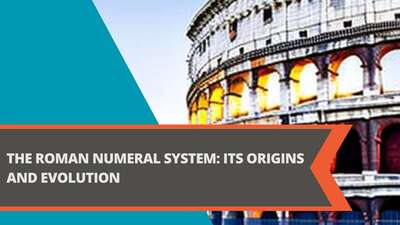How to Convert Arabic Numerals to Roman Numerals: A Comprehensive Guide
- The Definition of Roman Numerals
- The Formula for Converting Arabic Numerals to Roman Numerals
- Step 1: Identify the Significant Digits of the Arabic Numeral
- Step 2: Find the Corresponding Roman Numeral Values for Each Significant Digit
- Step 3: Combine the Roman Numeral Letters to Represent the Arabic Numeral
- Examples of Converting Arabic Numerals to Roman Numerals
- Example 1: Converting 42 to Roman Numerals
- Example 2: Converting 1492 to Roman Numerals
- Explanation of the Formula
- Question and Answer FAQ
- What is the origin of Roman numerals?
- Why are Roman numerals still used today?
- Are there any tips for converting Arabic numerals to Roman numerals?
- What is the largest number that can be represented by Roman numerals?
- Conclusion
Arabic numerals, also known as Hindu-Arabic numerals, are the most common numeral system used worldwide. However, there are times when you may need to convert Arabic numerals to Roman numerals, especially when dealing with historical dates, book chapters, or movie sequels. Roman numerals are a numeral system that originated in ancient Rome and are still used today, mostly for decorative purposes or to represent ordinal numbers. In this article, we'll explain the formula and provide examples for converting Arabic numerals to Roman numerals.
The Definition of Roman Numerals
Roman numerals are a numeral system that originated in ancient Rome and were used throughout the Roman Empire. Roman numerals are composed of letters from the Latin alphabet, and each letter represents a different value. The basic Roman numerals and their corresponding values are as follows:
| Roman Numeral | Value |
|---|---|
| I | 1 |
| V | 5 |
| X | 10 |
| L | 50 |
| C | 100 |
| D | 500 |
| M | 1000 |
It's essential to understand the values of each Roman numeral to convert Arabic numerals to Roman numerals.
The Formula for Converting Arabic Numerals to Roman Numerals
The formula for converting Arabic numerals to Roman numerals is relatively simple. The key is to identify the significant digits of the Arabic numeral and their corresponding values. Once you have done that, you can represent the Arabic numeral in Roman numerals by combining the appropriate Roman numeral letters. Here is the formula for converting Arabic numerals to Roman numerals:
Step 1: Identify the significant digits of the Arabic numeral.
Step 2: Find the corresponding Roman numeral values for each significant digit.
Step 3: Combine the Roman numeral letters to represent the Arabic numeral.
Let's take a closer look at each step.
Step 1: Identify the Significant Digits of the Arabic Numeral
The first step in converting an Arabic numeral to a Roman numeral is to identify the significant digits of the Arabic numeral. These significant digits are the ones that contribute to the overall value of the number. For example, in the Arabic numeral 1984, the significant digits are 1, 9, 8, and 4. The zeros do not contribute to the overall value of the number and are therefore not significant digits.
Step 2: Find the Corresponding Roman Numeral Values for Each Significant Digit
The next step is to find the corresponding Roman numeral values for each significant digit. You can use the table provided earlier to find the corresponding Roman numeral value for each significant digit. For example, the Roman numeral values for the significant digits in 1984 are as follows:
- 1 = I
- 9 = IX
- 8 = VIII
- 4 = IV
Notice that when a smaller value appears before a larger value, the smaller value is subtracted from the larger value. For example, 4 is represented by IV, not IIII, because 1 is subtracted from 5. The same rule applies to 9, which is represented by IX, not VIIII, because 1 is subtracted from 10.
Step 3: Combine the Roman Numeral Letters to Represent the Arabic Numeral
The final step is to combine the Roman numeral letters to represent the Arabic numeral. In our example, we have identified the significant digits of 1984 and found their corresponding Roman numeral values. Now we can combine the Roman numerals to represent the Arabic numeral 1984 as MCMLXXXIV.
Examples of Converting Arabic Numerals to Roman Numerals
Let's take a look at some examples of converting Arabic numerals to Roman numerals using the formula we just learned:
Example 1: Converting 42 to Roman Numerals
Step 1: Identify the significant digits of the Arabic numeral. In this case, the significant digits are 4 and 2.
Step 2: Find the corresponding Roman numeral values for each significant digit. The Roman numeral values for 4 and 2 are IV and II, respectively.
Step 3: Combine the Roman numeral letters to represent the Arabic numeral. The Roman numeral representation of 42 is XLII.
Example 2: Converting 1492 to Roman Numerals
Step 1: Identify the significant digits of the Arabic numeral. In this case, the significant digits are 1, 4, 9, and 2.
Step 2: Find the corresponding Roman numeral values for each significant digit. The Roman numeral values for 1, 4, 9, and 2 are I, IV, IX, and II, respectively.
Step 3: Combine the Roman numeral letters to represent the Arabic numeral. The Roman numeral representation of 1492 is MCDXCII.
Explanation of the Formula
The formula we provided earlier is a simple and effective way to convert Arabic numerals to Roman numerals. The first step is to identify the significant digits of the Arabic numeral. The second step is to find the corresponding Roman numeral values for each significant digit. The third and final step is to combine the Roman numeral letters to represent the Arabic numeral.
It's important to note that the formula only works for converting positive integers. It cannot be used to convert negative numbers, decimals, or fractions. In addition, there are some exceptions to the basic rules of Roman numerals, such as the use of the bar symbol (|) to represent 5,000 and the use of the vinculum to represent large numbers. However, these exceptions are rarely used in modern times.
Question and Answer FAQ
What is the origin of Roman numerals?
Roman numerals originated in ancient Rome and were used throughout the Roman Empire. They were used for a variety of purposes, including numbering pages in books, marking the hours on sundials, and recording dates on buildings and monuments.
Why are Roman numerals still used today?
While Roman numerals are not commonly used in everyday life, they are still used in some contexts, such as the numbering of movie sequels, the names of monarchs and popes, and the numbering of Super Bowls.
Are there any tips for converting Arabic numerals to Roman numerals?
One tip is to break the Arabic numeral down into significant digits and convert each digit individually. Another tip is to memorize the Roman numeral values for the digits 1-10, as these are the most commonly used values.
What is the largest number that can be represented by Roman numerals?
The largest number that can be represented by Roman numerals using the standard system is 3,999 (MMMCMXCIX). However, as mentioned earlier, there are exceptions to the basic rules of Roman numerals that allow for larger numbers to be represented using the vinculum.
Conclusion
Converting Arabic numerals to Roman numerals may seem daunting at first, but with the formula we provided and a little practice, it can be done quickly and easily. Remember to break the Arabic numeral down into significant digits, find the corresponding Roman numeral values, and combine the Roman numerals to represent the Arabic numeral. With these steps in mind, you'll be able to impress your friends and family with your newfound knowledge of Roman numerals.







